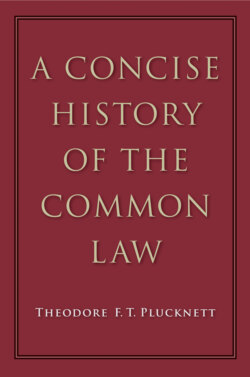Читать книгу A Concise History of the Common Law - Theodore F. T. Plucknett - Страница 159
На сайте Литреса книга снята с продажи.
THE TUDOR FINANCIAL COURTS
ОглавлениеThese courts have never been studied in detail and so little is known of them apart from the statutes creating them. If they were to be investigated, however, it might appear that the Tudors were not so prejudiced against the common law as is often supposed. It is perfectly true, as we shall see, that the Tudors developed the prerogative and equitable jurisdictions to a remarkable degree, but the creation of the financial courts seems to show that they were equally appreciative of common law forms, and were ready to use them on suitable occasions. Beside Chancery, Star Chamber and the Court of Requests, we must in fairness place those predominantly common law courts which were equally the creation of the Tudors, the Courts of Augmentations, First Fruits, Wards, Liveries (later combined with the Court of Wards), and Surveyors.5
The Court of Augmentations was erected by statute6 in 1536 partly as a department of audit, partly as an estate office, and partly as a franchise court (modelled in part on the chamber of the duchy of Lancaster7) to deal with the vast quantity of lands confiscated from the monasteries upon their suppression. Then, in 1540, the Court of First Fruits and Tenths was erected1 to manage sundry payments hitherto made to the popes, and recently transferred to the Crown.
In the same year, the Court of Wards was similarly constituted to manage the ancient feudal revenues of the Crown, and especially to enforce the rights of wardship and marriage,2 in 1540. As Coke3 observed, an office in that court was partly “ministerial” and partly judicial, so that the exercise of administrative as well as judicial powers by the same institution is particularly remarkable. In the next year a Court of Surveyors was established to manage other portions of the royal estates.4 It is noteworthy that these bodies were primarily administrative departments for the management on business lines of a vast quantity of property, but they were given judicial powers which were very likely to be used when the Crown itself was a party. From this point of view they resembled the old Exchequer, and it has been suggested that the example of the Exchequer practice was the inspiration for certain provisions which facilitated claims in these courts by subjects against the Crown.5 As courts they were not oppressive (although no doubt feudalism in itself gave rise to hardships). It is interesting to note that when the rights of the subject in litigation against the Crown were thoroughly examined in Pawlett v. Attorney-General6 and later in the Bankers’ Case7 the practice of the Exchequer and the Court of Augmentations was discussed.8
A curious point arose later in the reign when Henry VIII by letters patent dissolved and re-founded the Court of Augmentations and abolished the Court of Surveyors, although they had been created by statute. Under Edward VI doubts arose as to the propriety of this, and so an act was passed which grudgingly condoned this use of the prerogative.9 Queen Mary attempted (unsuccessfully) the still more curious feat of dissolving the Court of Augmentations, and (the next day) uniting it with the Exchequer.10
